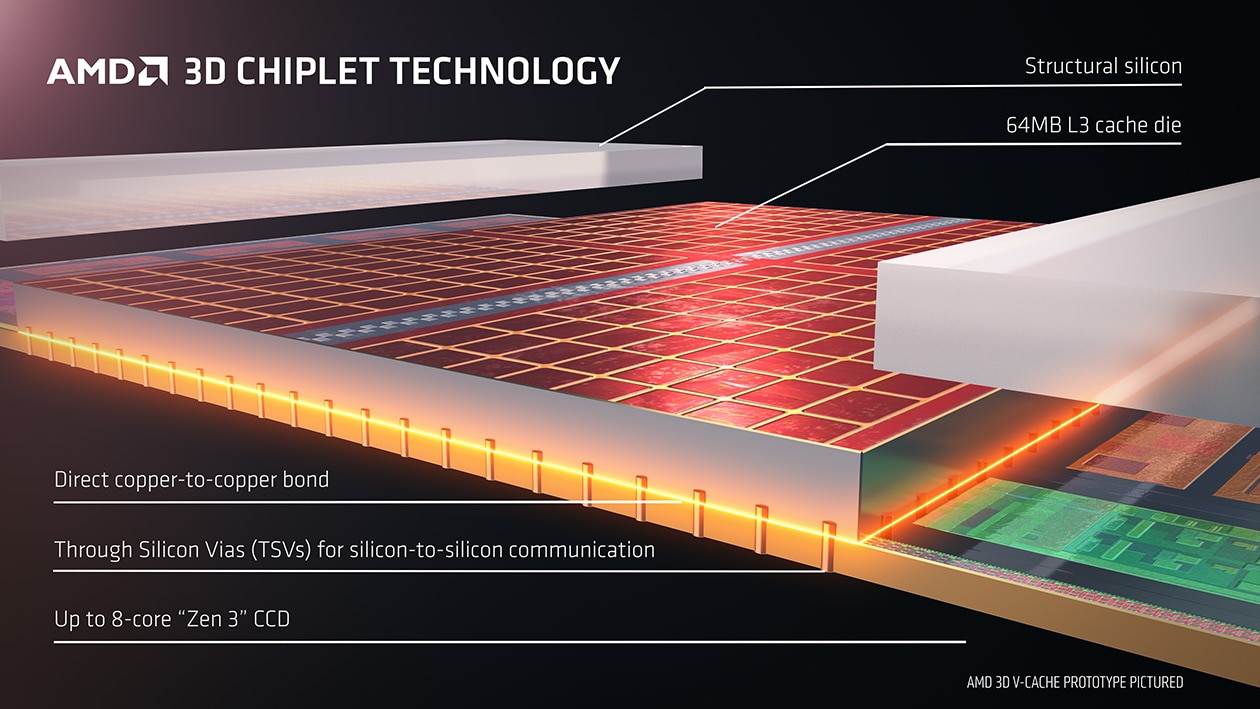
SOURCE: AMD
Until the release of Intelís 12th-generation Alder Lake CPUs, AMD had been on top of the gaming performance charts. It took years for the company to snatch the final pillar from Intel, having already beat them on core count, multithreaded work, power consumption, and price. It was just that single-core performance that help back AMD from being the CPU of choice for gabeatenming as well. Then the Ryzen series of chips finally overtook Intelís IPC (Instructions Per Clock) performance and it became hard to recommend Intel CPUs to anyone with even a semblance of a budget,
Intel had been struggling with its process nodes for some time, while AMD and other CPU makers are making inroads to 5nm chips, Intel is still stuck on a relatively massive 10nm process and it was too long ago that they were shipping 14nm parts.
The upside of this is that Intel had to refine its processes to get as much out of the process nodes they did have at hand. Alder Lake, with its revolutionary hybrid architecture, grabbed the gaming, general, and mobile crowns back from AMD. As long as you donít factor in price, but with the release of the Ryzen 7 5800X3D the gaming crown has moved again, and itís due to the lateral thinking represtented by 3D V-Cache.
What is 3D V-Cache?

SOURCE: AMD
As you probably already know, a CPU comes with cache memory that acts as a buffer between (relatively) slow RAM and the speed at which the CPU needs to be fed with instructions to use every ounce of itís processing power. If the CPU is waiting for instructions, it doesít matter how powerful it is, itís going to spend those cycles doing nothing.
Cache Basics
SOURCE: AMD
CPUs have relatively modest amounts of cache, and itís divided into levels representing how close to the actual CPU is. L1 (Level 1) cache is on the same die as the CPU itself, offering essentially the same speed. However, this type of cache memory takes up precious space, so thereís usually very little of it. The 5800X3D has a mere 512KB of L1 cache. L2 cache is integrated close to the CPU core, but doesnít share space with it, so it can be bigger but is slower and takes longer to get information to the CPU. The 5800X3D has 4MB of L2 cache.
Then we have L3 cache. L1 caches are specific to each core, L2 caches are often shared between pairs of cores, but the L3 cache in the 5800X3D is shared by all cores. Itís the slowest cache in the CPU package, but still at least twice as fast as RAM.
Why ď3DĒ Cache?
The 5800X3D has a whopping 96MB of L3 cache, so all cores have access to a relatively large high-speed cache area. However, the ď3DĒ part comes from how AMD has managed to fit that much cache memory into the CPU package.
Traditionally, integrated circuits are effectively 2D. Itís an image projected into a semiconductor substrate. So if you want more transistors in your chip, your only choices are to make them physically smaller, or make the chipís surface area bigger.
3D circuits use multiple layers of integrated circuits to vertically stack chips in layers, with special vertical connections. This is a tricky process, but AMD has found an effecgive way to layer L3 cache to offer much more of it at a competitive price.
Games Benefit the Most.

SOURCE: Tomís Hardware
AMD markets the 5800X3D specifically as a gaming chip and thereís good reason for this. The effect of cache on performance varies depending on the type of application.
Caches are all about predicting what data from RAM a CPU will want next. If youíre doing something like exporting a video or doing a CPU-based render of a scene, itís simple to make sure that the L1 cache always has the next bit of data. If youíre doing something with some branching possibilities, then the larger L2 cache is more likely to contain the correct data the CPU needs next.
Games and real-time simulations are much more dynamic than other types of software. In a game itís much less likely that L1 and L2 cache will contain the correct date.After all games react to user input, so therís an element of randomness thatís hard to deal with. If there are such ďcache missesĒ it means the CPU isnít fdoing as much work as itís capable of.
With such a large L3 cache, the 5800X3D makes is far more likely that the correct gaem data ends up in the cache and since this cache is available to all cores, games that have good multithreading also benefit.
Everything Else is Pretty Much the Same
As a gaming chip then, the 5800X3D canít be beat right now. Especially since itís quite a bit cheaper than Intelís flagship offerings while also performing better in this specific area.
However, if you take that massive L3 cache away, weíve seen this all before. Itís the same 7nm technology in other current Ryzen CPUs. Itís an 8-core, 16-thread system thatís perfectly competent at any other task you want to throw at it, but it wonít match up to itís competition at Intel for uses outside of gaming.
In other words, if gaming isnít your number one priority, you should look elsewhere. However, if you donít have money tied up to every second a render finishes early and mainly care about gaming performance, this is an easy CPU to recommend. Especially since the money you save can be put towards a better GPU. Also, since this is a Socket AM4 CPU, thereís a good chance you can perform a drop-in upgrade for your existing system, which is not something Intel can offer anyone with their 12th-gen parts.